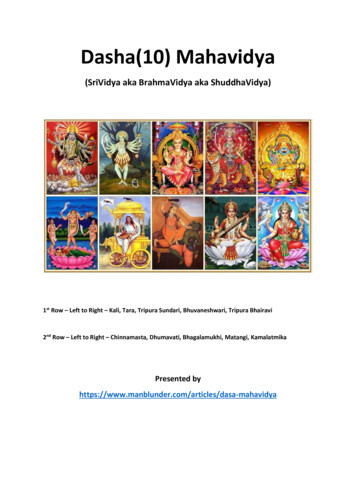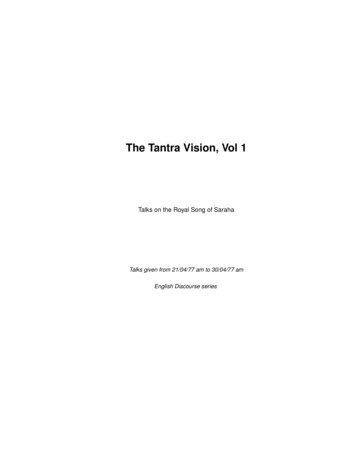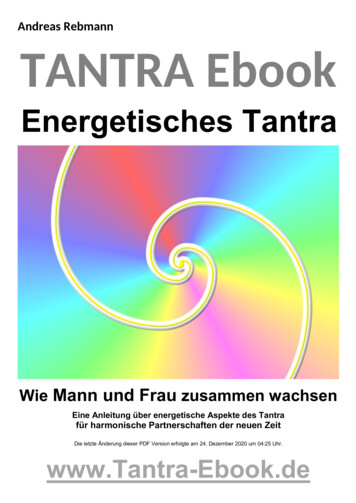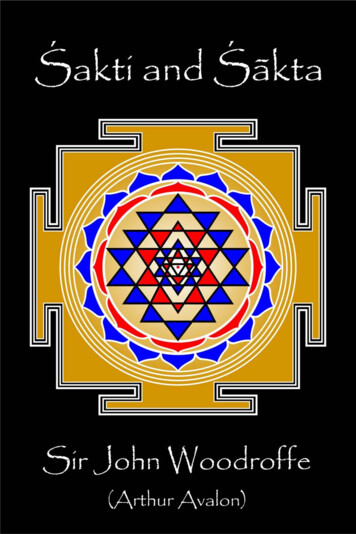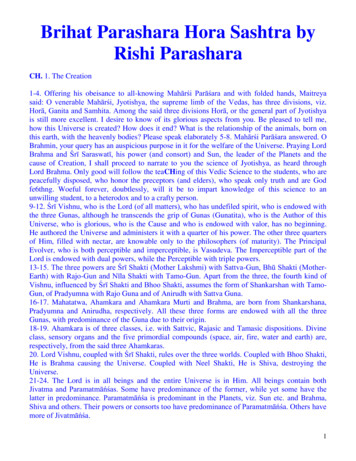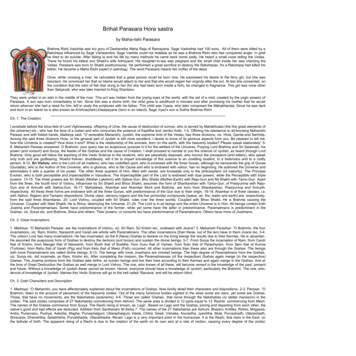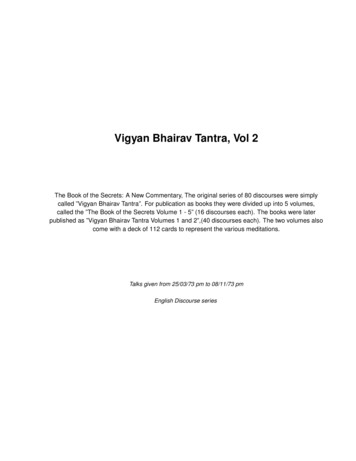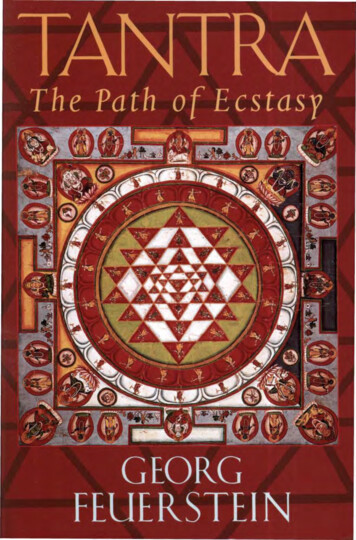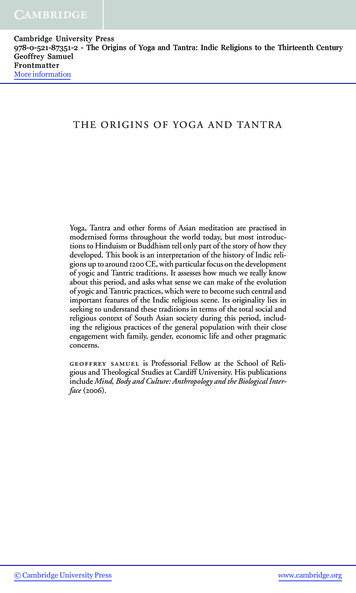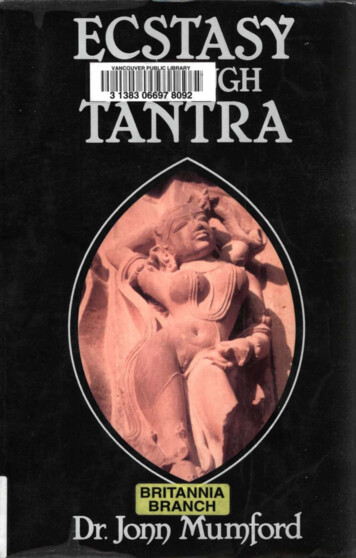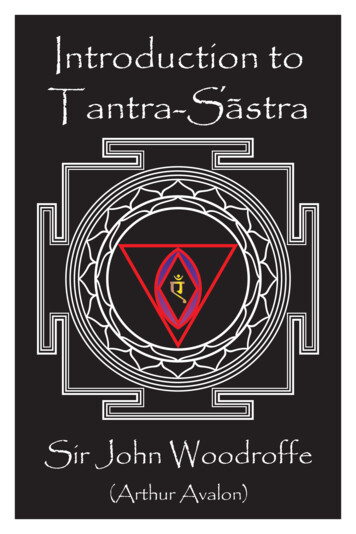
Transcription
Introduction toTantra-SastraSir John Woodroffe(Arthur Avalon)
INTRODUCTIONTOTANTRA ŚĀSTRASIR JOHN WOODROFFECelephaïs PressUlthar - Sarkomand - Inquanok – Leeds2008
Originally published as the Introduction to Mahānirvāṇ aTantra (Tantra of the Great Liberation), 1913. First issued as an independent work, Madras: Ganesh &co., 1952, many later printings. This electronictext produced by Celephaïs Press, Leeds,in the year 2008 of the commonerror.This work is in the public domain.Release 1.0.: 13.04.2008. May require further proof reading.Please report errors to dancingstar93@gmail.comciting revision number or release date.
CONTENTSPAGEMount Kailāsa. . .1Śiva and Śakti. . .4Guṇ a. . .18The Worlds (Lokas). . .24Inhabitants of the Worlds. . .26Varṇ a. . .31Āśrama. . .32Macrocosm and Microcosm. . .34The Ages. . .36The Scriptures of the Ages. . .40The Human Body. . .42The Three Temperaments. . .58Guru and Siṣ ya. . .65Initiation: Dīkṣ a. . .68Abhiṣ eka. . .70Sādhana. . .72Worship. . .73Yoga. . .125Sin and Virtue—Karma. . .142. . .147. . .154Four aims of Being (Dharma, Artha, Kāma,Moṣ ka)Siddhi
MOUNT KAILĀSATHE scene of the revelation of Mahānirvāna-Tantra islaid in Himālaya, the “Abode of Snow,” a holy landweighted with the traditions of the Āryan race. Here inthese lofty uplands, encircled with everlasting snows,rose the great mountain of the north, the Sapta-KulaParvata. Hence the race itself came, and there its earlylegends have their setting. There are still shown atBhimudiyar the caves where the sons of Pāṇ ḍ u andDraupadi rested, as did Rama and his faithful wife atthe point where the Kosi joins the Sitā in the grove ofAśoka trees. In these mountains Munis and Ṛ ṣ is lived.Here also is the Kṣ etra of Śiva Mahādeva, where hisspouse Parvatī, the daughter of the Mountain King, wasborn, and where Mother Ganges also has her source.From time immemorial pilgrims have toiled throughthese mountains to visit the three great shrines atGangotri,1 Kedarnath2 and Badrinath.3 At Kangri, further north, the pilgrims make the parikrama of MountKailāsa (Kang Rinpoche), where Śiva is said to dwell.This nobly towering peak rises to the north-west of the1Source of the Ganges.A matha and temple dedicated to Śri SadāŚiva in charge of the Śaivạascetics called Jangama. The Devatā is also worshipped at four other places2along the Himalayan chain—Tungnath, Rudranath, Madhmaheśwar, andKalpeśvar. These and the first-named form the “Panchkedar.”3A celebrated temple dedicated to an incarnation of the Deva Viṣ ṇ u, whofrom Kūrmācala is said to have descended in his Kūrma form.Badarika see Mahābhārata c. 92 Āraṇ ya-Parvan.As to
INTRODUCTION TO TANTRA ŚĀSTRA2sacred Manasarowar Lake (Mapham Yum-tso) fromamidst the purple ranges of the lower KangriMountains. The paradise of Śiva is a summerland ofboth lasting sunshine and cool shade, musical with thesong of birds and bright with undying flowers. The air,scented with the sweet fragrance of Mandhāra chaplets,resounds with the music and song of celestial singersand players. The Mount is Gaṇ a-parvata, throngedwith trains of Spirits (devayoni), of which the openingchapter of Mahānirvāṇ a-Tantra speaks.And in the regions beyond rises Mount Meru, centreof the world-lotus. Its heights, peopled with spirits, arehung with clusters of stars as with wreaths of Mālatiflowers. In short, it is written: 1 “He who thinks ofHimācala, though he should not behold him, is greaterthan he who performs all worship in Kāśi (Benares). Ina hundred ages of the Devas I could not tell thee of theglories of Himācala. As the dew is dried up by themorning sun, so are the sins of mankind by the sight ofHimācala.”It is not, however, necessary to go to the HimālayanKailāśa to find Śiva.He dwells wheresoever hisworshippers, versed in Kula-tattva, abide, 2 and Hismystic mount is to be sought in the thousand-petalledlotus 3 (sahasrarapadma) in the body of every humanjīva, hence called Śiva-sthana, to which all, wheresoeversituate, may repair when they have learned how toachieve the way thither.1Skanda-Purāṇ a.2Kulārṇ ava-Tantra (chap. IX).See Tripurāsāra, cited in Bhāskarāyas Commentary on Lalitā-sahaṣranāma, verse 17. Goroh sthanam hi Kaliāsam as the Yoginī-Tantra (chap. i)says.3
MOUNT KAILĀSA3Śiva promulgates His teaching in the world belowin the works known as Yāmala, Dāmara, Śiva-Sūtra,1and in the Tantras which exist in the form of dialoguesbetween the Devatā and his Śakti, the Devī in Her formas Pārvatī. According to the Gāyatri-Tantra,2 the DevaGaṇ eśa first preached the Tantra to the Devayoni onMount Kailāsa, after he had himself received them fromthe mouth of Śiva.After a description of the mountain, the dialogueopens with a question from Parvati3 in answer to whichand those which succeed it, S’iva unfolds His doctrine onthe subjects with which Mahā-nirvāṇ a-Tantra deals.1Of which the Śiva-Sūtra-Vimarśini is a Commentary.2Chapter X.3As the Devī is here the śiṣ ya, this Tantra is in the form called Āgama.
ŚIVA AND ŚAKTITHAT eternal immutable existence which transcends theturiya and all other states in the unconditionedAbsolute, the supreme Brahman or Para-brahman,without Prakṛ ti (niṣ kala) or Her attributes (nir-guṇ a),which, as being the inner self and knowing subject, cannever be the object of cognition, and is to be apprehended only through yoga by the realization of the Self(ātma-jñāna), which it is. For, as it is said, “Spirit canalone know Spirit.” Being beyond mind, speech, andwithout name, the Brahman was called “Tat,” “That,”and then “Tat Sat,” “That which is.” For the sun, moon,and stars, and all visible things, what are they but aglimpse of light caught from “That” (Tat)?Brahman is both niṣ kala and sakala. Kalā isPrakṛ ti. The niṣ kala-Brahman or Para-brahman is theTat when thought of as without Prakṛ ti (Prakṛ teranyā).It is called sakala when with Prakṛ ti.1 As the substanceof Prakṛ ti is the three guṇ as It is then sa-guṇ a, as in theprevious state It was nir-guṇ a. Though in the latterstate It is thought of as without Śakti, yet (makingaccommodation to human speech) in It potentially existsŚakti, Its power and the whole universe produced by It.To say, however, that the Śakti exists in the Brahman isbut a form of speech, since It and Śakti are, in fact, one,̣Śārada-tilaka (chap. i), and chap. i. of Śāktānanda-tarangini (“Waves ofBliss of Śaktas), both Tantrika works of great authority.1
ŚIVA AND ŚAKTI5and Śakti is eternal (Anādi-rūpā).1 She is Brahma-rūpāand both viguṇ a (nir-guṇ a) and sa-guṇ ā; the Caitanyarūpiṇ i-Devī, who Manifests all bhūta. She is the Ānandarūpiṇ ī Devī, by whom the Brahman manifests Itself,2and who, to use the words of the Śārada, pervades theuniverse as does oil the sesamum seed.In the beginning the Niṣ kala-Brahman aloneexisted. In the beginning there was the One. It willeḍ̣and became many.Aham-bahu-syām—“may I bemany.” In such manifestation of Śakti the Brahman isknown as the lower (apara) or manifested Brahman,who, as, the subject of worship, is meditated upon withattributes. And, in fact, to the mind and sense of theembodied spirit (jīva) the Brahman has body and form.It is embodied in the forms of all Devas and Devīs, andin the worshipper himself. Its form is that of the universe, and of all things and beings therein.̣As Śruti says: “He saw” (Sa aikṣ ata, aham bahusyām prajāyeya). He thought to Himself “May I bemany.” “Sa aikṣ ata” was itself a manifestation of Śakti,the Paramāpūrva-nirvāṇ a-śakti of Brahman as Śakti.3From the Brahman, with Śakti (Parahaktimaya) issuedNāda (Śiva-Śakti as the “Word” or “Sound”), and fromNāda, Bindu appeared. Kālicharana in his commentaryon the Ṣ aṭ cakra-nirūpaṇ a4 says that Śiva and Nirvāṇ aŚakti bound by a māyik bond and covering, should bẹthought of as existing in the form of Param Bindu.̣̣Pranamya prakṛ tim nityam paramātma-svarūpinim (loc. cit. Śāktạ̄nanda-tarangiṇ i).12Kubjika-Tantra, 1st Patala.3Ṣ aṭ -cakra-nirupaṇ a. Commentary on verse 49, “The Serpent Power.”4Ibid., verse 37.
INTRODUCTION TO TANTRA ŚĀSTRA6The Sāradā 1 says: Saccidānanda-vibhavāt sakalātparameśvarāt āsicchaktistato nādo, nadad bindusamudbhavah. (“From Parameśvara vested with thewealth of Saccidananda and with Prakṛ ti (sakala)issued Śakti; from Śakti came Nāda and from Nāda wasborn Bindu”). The state of subtle body which is knownas Kāma-kalā is the mūla of mantra. The term mūlamantrātmikā, when applied to the Devī, refers to thissubtle body of Hers known as the Kāma-kalā. 2 TheTantra also speaks of three Bindus, namely, Śiva-maya,Śakti-maya, and Śiva-Śakti maya.3̣The param-bindu is represented as a circle, thecentre of which is the brahma-pada, or place of Brahman,wherein are Prakṛ ti-Puruṣ a, the circumference of whichis encircling māyā.4 It is on the crescent of nirvāṇ a-kalāthe seventeenth, which is again in that of amā-kalā, thesixteenth digit (referred to in the text) of the moon-circle(Candra-maṇ ḍ ala), which circle is situate above thẹSun-Circle (Sūrya-maṇ ḍ ala), the Guru and the Hamsah,which are in the pericarp of the thousand-petalled lotus(saharārapadrna). Next to the Bindu is the fieryBodhinī, or Nibodhikā (v. post). The Bindu, with theNirvāṇ a-kalā, Nibodhikā, and Amā-kalā, are situated inthe lightning-like inverted triangle 5 known as “A, Ka,1Śārada-tilaka (chap. i).2See Bhāskararāya’s Commentary on the Lalitāsahasranāma, verse 36.3Prāṇ a-toṣ ini (p. 8).4̣Māyābandhanacchaditaprakr tipuruṣ a-param binduh. Commentary toverse 49 of the Ṣ aṭ -cakra-nirupaṇ a.5 The Devī-Puraṇ a says that Kuṇ ḍ alinī is so called because She has thẹŚṛ ngaṭ āka or triangle form, the three angles being the icchā, jñāna andkriyā-Śaktis (see also Yoginī-hṛ daya).
ŚIVA AND ŚAKTI7Tha” and which is so called because at its apex is A; atits right base is Ka; and at its left base Tha. It is madeup of forty-eight letters (mātṛ kā); the sixteen vowelsrunning from A to Ka; sixteen consonants of the kavarga and other groups running from Ka to Tha; andthe remaining sixteen from Tha to A. Inside are theremaining letters (mātṛ kā), ha, la (second), and kṣ a.1 Asthe substance of Devī is matṛ ka (mātṛ kāmayī) thetriangle represents the “Word” of all that exists. Thetriangle is itself encircled by the Candra-maṇ ḍ ala. TheBindu is symbolically described as being like a grain ofgram (caṇ aka), which under its encircling sheatḥcontains a divided seed. This Param-bindu is prakṛ tiPuruṣ a, Śiva-Śakti.2 It is known as the Śabda-Brahman(the Sound Brahman), or Apara-brahman. 3 A polarization of the two Śiva and Śakti-Tattvas then takesplace in Paraśakti-maya. The Devī becomes Unmukhī.Her face turns towards Śiva. There is an unfoldingwhich bursts the encircling shell of Māyā, and creationthen takes place by division of Śiva and Śakti or of̣“Ham” and “Sah.” 4 The Śārada says: “The Devatāparaśakti-maya is again Itself divided, such divisionsbeing known as Bindu, Bīja, and Nāda.5 Bindu is of thenature of Nāda of Śiva, and Bīja of Śakti, and Nāda has1Ṣ aṭ -cakra-nirupaṇ a.2Ṣ aṭ -cakra-nirupaṇ a, Commentary, verse 49.3Śārada-tilaka, (Chap. i):Bhidyamant parad bindoravyaktatmaravo’bhavaṭŚabda-brahmeti tam prāhuh.̣“From the unfolding Parambindu arose an indistinct sound. This bindu iscalled the Śabdu-brahman.”4Ṣ aṭ -cakra-nirupaṇ a, verse 49.5That is, tese are three different aspects of It.
INTRODUCTION TO TANTRA ŚĀSTRA8been said to be the relation of these two by those whoare verse in all the Āgamas.” 1 The Śārada says thatbefore the bursting of the shell enclosing the Brahmapada, which, together with its defining circumference,constitutes the Śabda-brahman, an indistinct soundarose (avyaktātmā-ravo’ bhavat). This avyaktanāda isboth the first and the last state of Nāda, according as itis viewed from the standpoint of evolution or involution.For Nāda, as Rāghava-bhaṭ ṭ a 2 says, exists in threestates. In Nāda are the guṇ as (sattva, rajas, andtamas), which form the substance of Prakṛ ti, which withŚiva It is. When tamo-guna predominates Nāda ismerely an indistinct or unmanifested (dhvanyatmako’vyaktanādah3) sound in the nature of dhvani. In thisstate, in which it is a phase of Avyakta-nāda, it is calledNibodhikā, or Bodhinī. It is Nāda when rajo-guna is inthe ascendant, when there is a sound in which there issomething like a connected or combined disposition ofthe letters.4 When the sattva-guna preponderates Nādaassumes the form of Bindu. 5 The action of rajas ontamas is to veil. Its own independent action effects anarrangement which is only perfected by the emergenceof the essentially manifesting sattvika-guṇ a set intoplay by it. Nāda, Bindu, and Nibodhikā, and the Śakti,1Chapter 1:Paraśaktimayah sākṣ at tridhāsau bhidyate punah.Bindurnādo bījam iti tasya bhedāh samīritah.̣Binduh Śivātmako bījam Śaktirnādastayormithah.Samavāyah samākhyatāh sarvāga-maviśaradaih.2See Commentary on verse 48 of the Ṣ aṭ -cakra-nirupaṇ a.Tamo-guṇ ādhikyena kevala-dhvanyātmako’vyakta-nādah.lit. unspoken, hidden, unmanifest, etc.̣4 Raja’adhikyena kimcidvarṇ a-nyāsātmakāh.35Sattvādhikyena bindurūpah.Avyakta is
ŚIVA AND ŚAKTI9of which they are the specific manifestations, are said tobe in the form of Sun, Moon and Fire respectively. 1Jñāna (spiritual wisdom2) is spoken of as fire as it burnsup all actions, and the tamo-guṇ a is associated with it.For when the effect of cause and effect of action arereally known, then action ceases. Icchā is the Moon.The moon contains the sixteenth digit, the Amā-kalāwith its nectar, which neither increases nor decays, andIcchā or will is the eternal precursor of creation. Kriyāis like Sun for as the Sun by its light makes all thingsvisible, so unless there is action and striving therecannot be realization or manifestation. As the Gitāsays: “As one Sun makes manifest all the lokas.”The Śabda-Brahman manifests Itself in a triad ofenergies—knowledge (jñānaśakti), will (icchā-śakti), andaction (kriyā-śakti), associated with the three guṇ as of̣Prakṛ ti, tamas, sattva, and rajas. From the ParamBindu who is both bindvātmaka and kalātma—i.e.,Śakti—issued Raudri, Rudra and his Śakti, whose formsare Fire (vahni), and whose activity is knowledge(jñāna); Vāmā and Viṣ ṇ u and his Śakti, whose form isthe Sun and whose activity is Kriyā (action): andJyeṣ ṭ ha and Brahma and his Śakti, whose form is theMoon and whose activity is desire. The VāmakeśvaraTantra says that Tri-purā is three-fold, as Brahmā,Viṣ ṇ u and Īśa; and as the energies desire, wisdom and1 Tataśca nāda-bindu-nibodhikāh arkenduvahnirūpah (Ṣ aṭ cakra, verse49, note). See also the Śāradā (chap. i), which says te (that is, Raudri,Jyeṣ ṭ ha, and Vāmā) jñānecchākriyātmano vahnīndvarka-svarūpiṇ ah.2 Jñāna is the knowledge which gives liberation. All other knowledge iscalled vijñāna.
INTRODUCTION TO TANTRA ŚĀSTRA10action;1 the energy of will when Brahman would create;the energy of wisdom when She reminds Him, saying“Let this be thus,” and when, thus knowing, He acts,She becomes the energy of action. The Devī is thusIcchā-śakti-jñāna-śakti-kriyā-śakti svarūpiṇ i.2Para-Śiva exists as a septenary under the form,firstly, of Śambhu, who is the associate of time (Kālabandhu). From Him issues Sadā-Śiva, Who pervadesand manifests all things, and then come Iśāna and thetriad, Rudra, Viṣ ṇ u and Brahma, each with His respective Śakti (without whom they avail nothing 3 ) separately and particularly associated with the guṇ as, tamas,sattva and rajas. Of these Devas, the last triad,together with Iśāna and Sadā-Śiva, are the five Śivaswho are collectively known as the Mahā-preta, whosebīja is “Hsauh.” Of the Mahā-preta, it is said that thelast four form the support and the fifth the seat, of thebed on which the Devī is united with Parama-śiva, inthe room of cintāmani stone;4 on the jewelled island cladwith clumps of kadamba and heavenly trees set in theocean of Ambrosia.5̣See Prāṇ a-toṣ ini (pp. 8, 9). Goraksha Sanmita and Bhuta-shuddhiTantra. See also Yoginī-Tantra, Part I, chap x.12Lalitā, verse 130 (see Bhāskararāya’s Commentary).And so the Kubjika Tantra (chap. i) says : " Not Brahma, Viṣ ṇ u, Rudracreate, maintain or destroy; but Brahmi, Vaiṣ navi, Rudrāni. Their husbandsare as but dead bodies.”3The “stone which grants all desires” is described in the Rudrayāmalaand Brahmānda-Purāṇ a. It is the place of origin of all those Mantras whichbestow all desired objects (cintita).̣5 See Ānandalahari of Samkarācarya, (verse 8), and Rudrayāmala.According to the Bahurpastaka and Bhairavayāmala, the bed is Śiva, the pillowMaheśana, the matting Śadaśiva, and the four supports Brahma, Hari,Rudra and Iśāna. Hence Devi is called Pancha-preta-mancādhisāyini (verse174, Lalitāsahasran āma).4
ŚIVA AND ŚAKTI11Śiva is variously addressed in this work as Śambhu,̣Sadā-śiva, Śamkara, Maheśvara, etc., names whichindicate particular states, qualities and manifestation ofthe One in its descent towards the many; for there aremany Rudras. Thus Sadā-śiva indicates the predominance of the sattva-guṇ a. His names are many, 1,008being given in the sixty-ninth chapter of the Śiva-Purāṇ a and in the seventeenth chapter of the AnuśāsanaParvan of the Mahābharata.1Śakti is both māyā, that by which the Brahmancreating the universe is able to make Itself appear to bedifferent from what It really is, 2 and mūla-prakṛ ti, orthe unmanifested (avyakta) state of that which, whenmanifest, is the universe of name and form. It is theprimary so-called “material cause,” consisting of theequipoise of the triad of guṇ a or “qualities” which aresattva (that which manifests), rajas (that which acts),tamas (that which veils and produces inertia). Thethree gunas represent Nature as the revelation of spirit,Nature as the passage of descent from spirit to matter,or of ascent from matter to spirit and nature as thedense veil of spirit.3 The Devī is thus guṇ a-nidhi4 (treasure-house of guṇ a). Mūla-prakṛ ti is the womb intoSee also the Agni, Padma, Bhaviṣ yottara, Varaha, Kūrma, VāmanaPurāṇ as, and in particular, the Linga and the Kāsikhānda of the SkandaPurāṇ a.2 The Devī Purāna (chap. xiv), speaking of this power of the Supreme,says: “That which is of various cause and effect; the giver of unthought-offruit which in this world seems like magic or a dream; that is called māyā”;1Vicitra-kāryakāraṇ ācintitāphalapradāSvapnedrajālavalloke māyā tena prakirtita.See post, sub voce “Guṇ a.”Lalitā-sahasra-nāma, (verse 121). For though the Guṇ as are specificallythree they have endless modifications.34
INTRODUCTION TO TANTRA ŚĀSTRA12which Brahman casts the seed from which all things areborn.1 The womb thrills to the movement of the essentially active rajo-guṇ a. The equilibrium of the triad isdestroyed and the guṇ a, now in varied combinations,evolves under the illumination of Śiva (cit), the universewhich is ruled by Maheśvara and Maheśvari. The dualprinciples of Śiva and Śakti, which are in such dualform the product of the polarity manifested in Parāśakti-maya, pervade the whole universe and are presentin man in the Svayambhū-Linga of the muladhara andthe Devī Kuṇ ḍ alinī, who, in serpent form, encircles it.The Śabda-Brahman assumes in the body of man theform of the Devī Kuṇ ḍ alinī, and as such is in all prāṇ is(breathing creatures) and in the shape of letters appearsin prose and verse. Kuṇ ḍ ala means coiled. HenceKuṇ ḍ alinī, whose form is that of a coiled serpent, meansthat which is coiled. She is the luminous vital energy(jīva-śakti) which manifests as prāṇ a, She sleeps in themūlādhāra and has three and a half coils correspondingin number with the three and a half bindus of which theKubjikā-Tantra speaks. When after closing the ears thesound of Her hissing is not heard death approaches.From the first avyakta creation issued the secondmahat, with its three guṇ as distinctly manifested.̣Thence sprung the third creation ahamkāra (selfhood),which is of threefold form—vaikārika, or pure sāttvikạ̣ahamkāra; the taijasa or rājasika ahamkāra; and thẹtāmasika or bhūtādika ahamkāra. The latter is theorigin of the subtle essences (tanmātrā) of the Tattvas,ether, air, fire, water, earth, associated with sound,touch, sight, taste, and smell, and with the colours—1Bhagavad-gitā (Chap. xiv).
ŚIVA AND ŚAKTI13pure transparency, śyāma, red, white, and yellow.There is some difference in the schools as to that whicheach of the three forms produces but from such threefolḍform of Ahamkāra issue the indriyas (“senses,” and theDevas Dik, Vāta, Arka, Pracetas, Vahni, Indra, Upendra, Mitra, and the Aśvins. The vaikārika, taijasa, andbhūtādika are the fourth, fifth, and sixth creations,which are known as prākrita, or appertaining to Prakṛ ti. The rest, which are products of these, such as thevegetable world with its upward life current, animalswith horizontal life current and bhūta, preta and thelike, whose life current tends downward, constitute thevaikrta creation, the two being known as the kaumāracreation.The Goddess (Devī) is the great Śakti. She is Māyạ̄for of Her the māyā which produces the samsāra is. AsLord of māyā She is Mahāmāyā.1 Devī is avidyā (nescience) because She binds and vidya (knowledge) becausẹShe liberates and destroys the samsara. 2 She is Prakṛ ti,3 and as existing before creation is the Ādyā (primordial) Śakti. Devī is the vācaka-śakti, the manifestation of Cit in Prakṛ ti, and the vāchya-Śakti, or Cititself. The Ātmā should be contemplated as Devī.4 Śaktior Devī is thus the Brahman revealed in Its motheraspect (Śri-māta) 5 as Creatrix and Nourisher of theworlds. Kālī says of Herself in Yogini-Tantra:6 “Saccid1 Mahāmāyā without māyā is nir-guṇ ā; and with māyā Sa-guṇ a; Śaktānanda tarangini, Chap. 1.2 Śāktānanda-tarangini (chap. i).3 Brahma-vaivarta Purāṇ a (chap. i). Pakṛ tikhānda. Nāradīdya Purāṇ a.4 See chap. ii. of Devī-bhāgavata.5 Devī is worshipped on account of Her soft heart: (komalāntahkaranam).Śāktānanda-tarangini (chap. iii.)6 Part I, Chapter X.
INTRODUCTION TO TANTRA ŚĀSTRA14̣ānanda-rūpāham brahmai-vāhām sphurat-prabham.”So the Devī is described with attributes both of thequalified1 Brahman and (since that Brahman is but themanifestation of the Absolute) She is also addressedwith epithets, which denote the unconditioned Brahman.2 She is the great Mother (Ambikā) sprung fromthe sacrificial hearth of the fire of the Grand consciousness (cit); decked with the Sun and Moon; Lalitā, “Shewho plays”; whose play is world-play; whose eyes playinglike fish in the beauteous waters of her Divine face,open and shut with the appearance and disappearanceof countless worlds now illuminated by her light, nowwrapped in her terrible darkness.3The Devī, as Para-brahman, is beyond all form andguṇ a. The forms of the Mother of the Universe are threefold. There is first the Supreme (para) form, of which,as the Viṣ ṇ u-yāmala says,4 “none knows.” There is nexther subtle (Sūkṣ ma) form, which consists of mantra. Butas the mind cannot easily settle itself upon that which isformless,5 She appears as the subject of contemplationin Her third, or gross (Sthūla), or physical form, withhands and feet and the like as celebrated in the Devīstotra of the Purāṇas and Tantras. Devī, who as Prakṛ tiis the source of Brahma, Viṣ ṇ u, and Maheśvara, 6 hasSuch as Mukunda, an aspect of Viṣ ṇ u. Lalitā-sahasra-nāmā, verse 838.Ibid, verse 153, and Commentator’s note to Chapter II where Devi iṣ̣addressed as Supreme Light (param-jyotih) Supreme Abode (paramdhāma)Supreme of Supreme (parātparā).3 See the Lalitā-sahasra-nāmā.4 Mātatsvat-param-rūpam tanna jānāti kaṣ chan (see chap. iii of Śāktānanda-tarangini).̣5 Amūrtaucit-sthrio na syāt tato mūrttim vicintayet (ibid. chap. i, as wasexplained to Himāvat by Devi in the Kūrma Purāṇ a).6 Ibid., and as such is called Tripurā (see Bhāskararāyas Commentary on12Lalitā, verse 125.
ŚIVA AND ŚAKTI15both male and female forms.1 But it is in Her femaleforms that she is chiefly contemplated. For though existing in all things, in a peculiar sense female beings areparts of Her.2 The Great Mother, who exists in the formof all Tantras and all Yantras,3 is, as the Lalita says,the “unsullied treasure-house of beauty”; the SapphireDevī,4 whose slender waist,5 bending beneath the burdenof the ripe fruit of her breasts,6 wells into jewelled hipsheavy7 with the promise of infinite maternities.8As the Mahadevi 9 She exists in all forms asSarasvatī, Lakṣ mi, Gāyatrī, Durgā, Tripurā-sundarī,12Ibid., chap. iii, which also says that there is no eunuch form of God.So in the Candi (Mārkandeya-Purāna) it is said:Vidyah samastastava devī bhedahStriyah samastāh sakalā jagatsu.See author’s “Hymns to the Goddess.” The Tantrika more than all men, recognises the divinity of woman, as was observed centuries past by the Authorof the Dabistān. The Linga-Purāna also after describing Arundhati, Anasūyā, and Shachi to be each the manifestation of Devī, concludes: “All thingsindicated by words in the feminine gender are manifestations of Devī.”3Sarva-tantra-rūpā; Sarva-yantrātmikā (see Lalitā, verses 205-6).4Padma-purāṇ a says, “Viṣ ṇ u ever worships the Sapphire Devī.”Āpivara-stana-tating tanuvrittamadhyām (Bhuvaneśvaristotra), “tanūmadhyā (Lalitā, verse 79) Krisodar (Ādyakālisvarūpa stotra, Mahā-nirvāṇ aTantra, seventh Ullāsa).56 Pinā-stanādye in Karpūrādistotra, pinonnata-payodharām in Durgādhyāna of Devī Purāṇ a: Vaksho-kumbhāntari in Annapūrṇ āstava, āpivarastana-tatim in Bhuvaneśvaristotra; which weight her limbs, hucha-bharanamitāngim in Sarasvatī-dhyāna; annapradāna-niratāng-stana-bhāra-namrām in Anna-pūrṇ āstava.So it is said in the tenth sloka of the Karpūrākhyastava—samantādạ̄pīnastana jaghanadhrikyauvanavati. Śamkarācaryā, in his Tripura-sundarīstotra speaks of her nitamba (nitamba-jita-bhūdharām) as excelling themountains in greatness.78 The physical characteristics of the Devī in Her swelling breasts and hipsare emblematic of Her great Motherhood for She is Śrīmātā (see as to Herlitanies, “Hymns to the Goddess.”9She whose body is, as the Devī Purāṇ a says, immeasurable.
INTRODUCTION TO TANTRA ŚĀSTRA16Annapūrṇ ā, and all the Devīs who are avataras of theBrahman.1Devi, as Sati, Umā, Parvati, and Gaūrī, is spouse ofŚiva. It was as Sati prior to Dakṣ a’s sacrifice (dakṣ ayajna) that the Devī manifested Herself to Śiva2 in theten celebrated forms known as the daśa-mahāvidyareferred to in the text—Kālī, Bagalā, Chinnamastā,Bhuvaneśvarī, Mātanginī, Shodaśi, Dhūmāvatī, Tripurasundari, Tārā, and Bhairavī. When, at the Dakṣ ayajna She yielded up her life in shame and sorrow at thetreatment accorded by her father to Her Husband, Śivatook away the body, and, ever bearing it with Him,remained wholly distraught and spent with grief. Tosave the world from the forces of evil which arose andgrew with the withdrawal of His Divine control, Viṣ ṇ uwith His discus (cakra) cut the dead body of Sati, whichŚiva bore, into fifty3-one fragments, which fell to earthat the places thereafter known as the fifty-onemahāpītha-sthāna (referred to in the text), where Devī,with Her Bhairava, is worshipped under various names.Besides the forms of the Devī in the Brahmāṇ ḍ a,there is Her subtle form Kuṇ ḍ alinī in the body (piṇ ‐ḍ āṇ da). These are but some only of Her endless forms.She is seen as one and as many, as it were, but onemoon reflected in countless waters.4 She exists, too, in1Śāktānanda-taranginī (chap. iii).In order to display Her power to Her husband, who had not granted ather request, His permission that she might attend at Dakṣ a’s sacrifice. Seemy edition of the “Tantra-tattva” (Principles of Tantra), and for an account ofthe daśa-mahāvidyā—their yantra and mantra—the daśa-mahāvidyaupāsana-rahasya of Prasanna Kumāra Śāstri.23The number is variously given as 50, 51 and 52.4Brahma-bindu Upaniṣ ad, 12.
ŚIVA AND ŚAKTI17all animals and inorganic things, the universe with allits beauties is, as the Devī Purāṇ a says but a part ofHer. All this diversity of form is but the infinite manifestation of the flowering beauty of the One SupremeLife, 1 a doctrine which is nowhere else taught withgreater wealth of illustration than in the Śākta-Śāstrasand Tantras. The great Bharga in the bright Sun andall devatas, and indeed, all life and being, are wonderful, and are worshipful but only as Her manifestations.And he who worships them otherwise is, in the words ofthe great Devī-bhāgavata,2 “like unto a man who, withthe light of a clear lamp in his hands, yet falls into somewaterless and terrible well.” The highest worship forwhich the sādhaka is qualified (adhikāri) only afterexternal worship3 and that internal form known as sādhāra,4 is described as nirādhārā. Therein Pure Intelligence is the Supreme Śakti who is worshipped as thevery Self, the Witness freed of the glamour of the manifold Universe. By one’s own direct experience of Maheśvari as the Self She is with reverence made the objectof that worship which leads to liberation.51See the Third Chapter of the Śāktānanda-taranginī, where it is said“The Para-brahman, Devī, Śiva, and all other Deva and Devī are but one, andhe who thinks them different from one another goes to Hell.”23Hymn to Jagad-ambikā in Chapter XIX.̣Sūta-samhitā, i.5.3, which divides such worship into Vedic and Tāntrik(see Bhāskararāya’s Commentary on Lalitā, verse 43).4In which Devī is worshipped in the form made up of sacred syllablesaccording to the instructions of the Guru.5See Introduction to Author’s “Hymns to the Goddess.”
GU Ṇ AIT cannot be said that current explanations give a clearunderstanding of this subject. Yet such is necessary,both as affording one of the chief keys to Indian philosophy and to the principles which govern Sādhana. Theterm guṇ a is generally translated “quality,” a word whichis only accepted for default of a bett
as Kāma-kalā is the mūla of mantra. The term mūla-mantrātmikā, when applied to the Devī, refers to this subtle body of Hers known as the Kāma-kalā.2 The Tantra also speaks of three Bindus, namely, Ś
